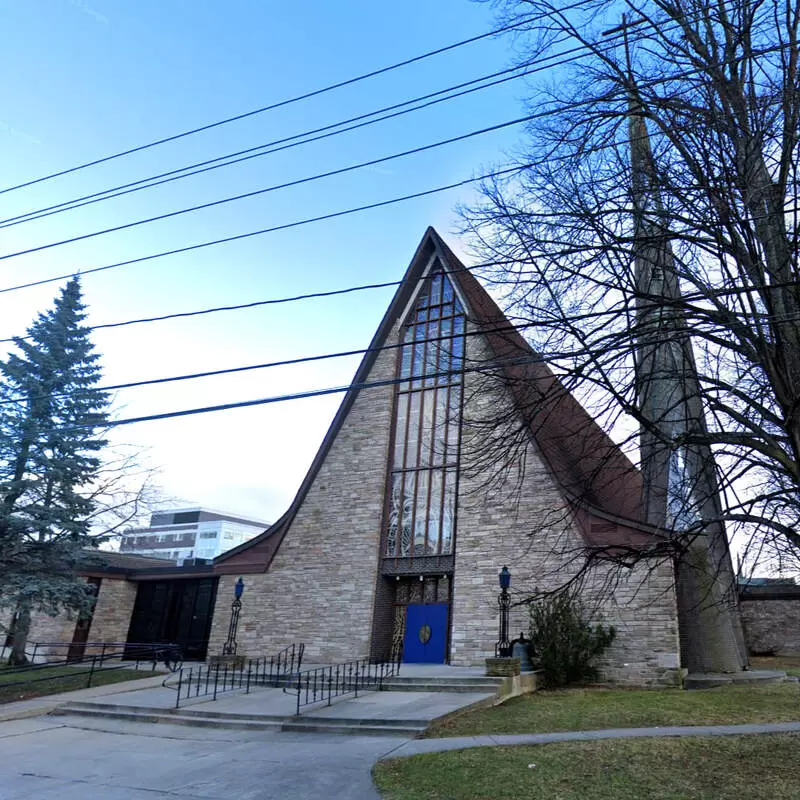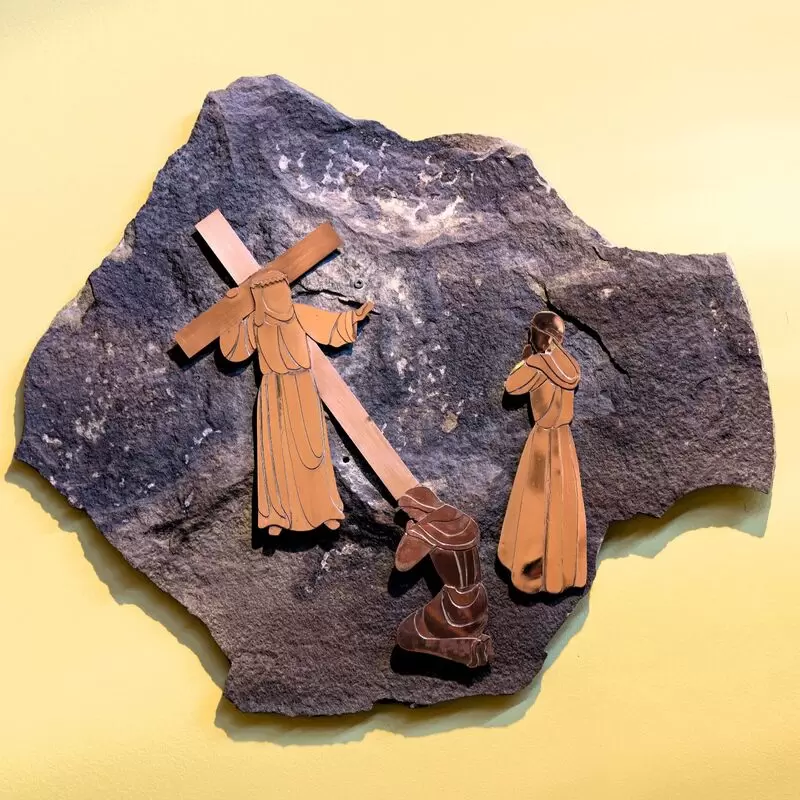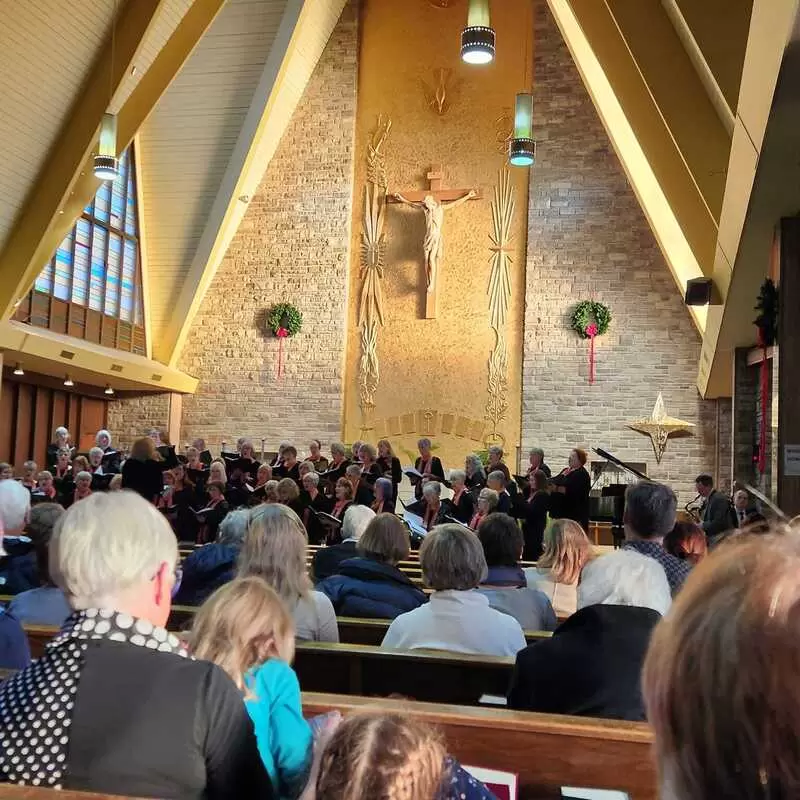St. Dunstan's Catholic Church Fredericton Photo Gallery
Church Photos
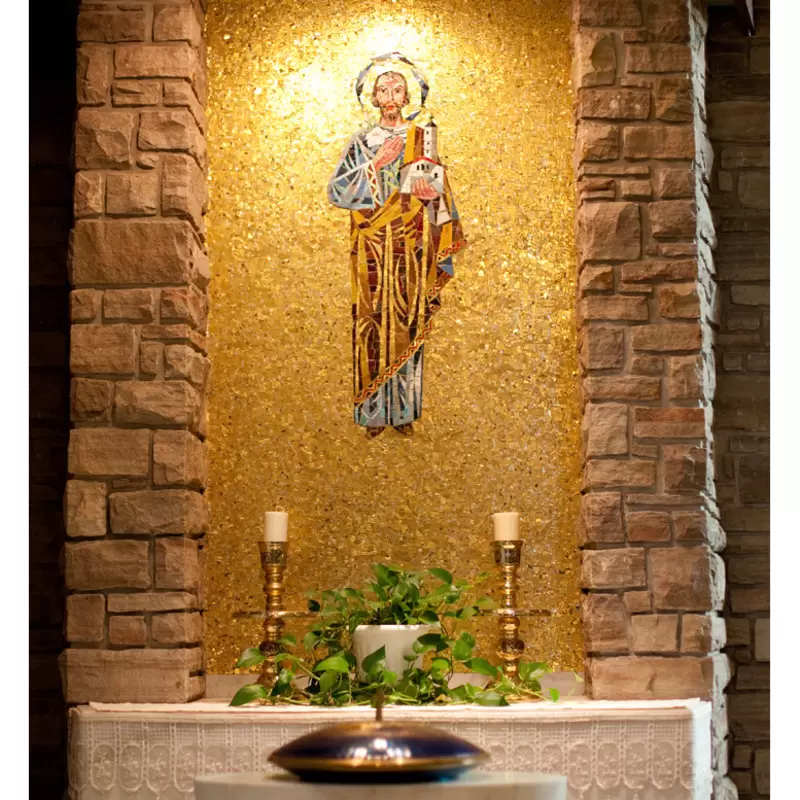
St. Joseph Side Altar
This altar is dedicated to St. Joseph, the husband of Mary. His symbols are the lily, which means purity, and a church. He holds the church in his hand because he is the patron saint of the universal church - that is, he is the patron saint of all the churches in the world. On the front of the altar is another lily. This one refers to a popular story about Joseph. According to this story, several young men wanted to be Mary's husband. The high priest told them to throw staffs (walking sticks), into the courtyard of the temple. When Joseph's hit the ground, it burst into bloom, and so he was chosen to be Mary's husband.
This may be just a story, but the image of the lily is a wonderful reminder of Joseph. There is also a carpenter's square and two doves on the front of this altar. The square is there because Joseph was a carpenter. The doves represent the sacrifice offered in the temple when Jesus was born. Back then, Jewish law said that all firstborn children belonged to God. To symbolize this special kind of belonging, parents had to offer a sacrifice. If you were rich, you could offer lambs or goats. Two doves would have been a poor family's offering.
This altar is dedicated to St. Joseph, the husband of Mary. His symbols are the lily, which means purity, and a church. He holds the church in his hand because he is the patron saint of the universal church - that is, he is the patron saint of all the churches in the world. On the front of the altar is another lily. This one refers to a popular story about Joseph. According to this story, several young men wanted to be Mary's husband. The high priest told them to throw staffs (walking sticks), into the courtyard of the temple. When Joseph's hit the ground, it burst into bloom, and so he was chosen to be Mary's husband.
This may be just a story, but the image of the lily is a wonderful reminder of Joseph. There is also a carpenter's square and two doves on the front of this altar. The square is there because Joseph was a carpenter. The doves represent the sacrifice offered in the temple when Jesus was born. Back then, Jewish law said that all firstborn children belonged to God. To symbolize this special kind of belonging, parents had to offer a sacrifice. If you were rich, you could offer lambs or goats. Two doves would have been a poor family's offering.
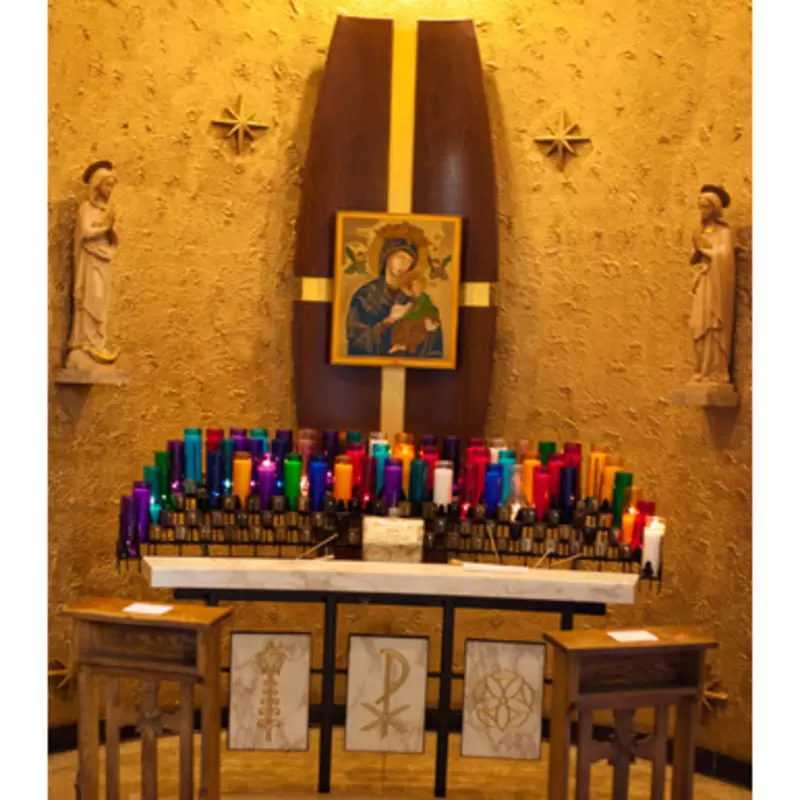
Our Lady of Perpetual Help Shrine
This is a shrine, like the one on the other side of the church, where people can light candles and say prayers. This is a shrine to Mary, who is sometimes called Our Lady of Perpetual Help.
There are three portraits of Mary here. The first, on the right, shows Mary as the Immaculate Conception. In the middle is a painting called Our Lady of Perpetual Help. She is always painted in the same way. The third portrait is another statue of Mary, this time as the Assumption. The church teaches us that when she died, Mary went straight to heaven, body and soul.
Other symbols found in the shrine in front of the candles include the lily - the symbol of purity; the Chi-Rho (P-X) - the first two Greek letters of the word 'Christ'; and the cinquefoil, which means 'five leaves' - it is a stylized rose. The rose is there as a symbol for Mary because sometimes Mary is called the 'Mystical Rose'. Again, the offertory candles are lit as reminders of our prayers, burning even after we have left.
This is a shrine, like the one on the other side of the church, where people can light candles and say prayers. This is a shrine to Mary, who is sometimes called Our Lady of Perpetual Help.
There are three portraits of Mary here. The first, on the right, shows Mary as the Immaculate Conception. In the middle is a painting called Our Lady of Perpetual Help. She is always painted in the same way. The third portrait is another statue of Mary, this time as the Assumption. The church teaches us that when she died, Mary went straight to heaven, body and soul.
Other symbols found in the shrine in front of the candles include the lily - the symbol of purity; the Chi-Rho (P-X) - the first two Greek letters of the word 'Christ'; and the cinquefoil, which means 'five leaves' - it is a stylized rose. The rose is there as a symbol for Mary because sometimes Mary is called the 'Mystical Rose'. Again, the offertory candles are lit as reminders of our prayers, burning even after we have left.
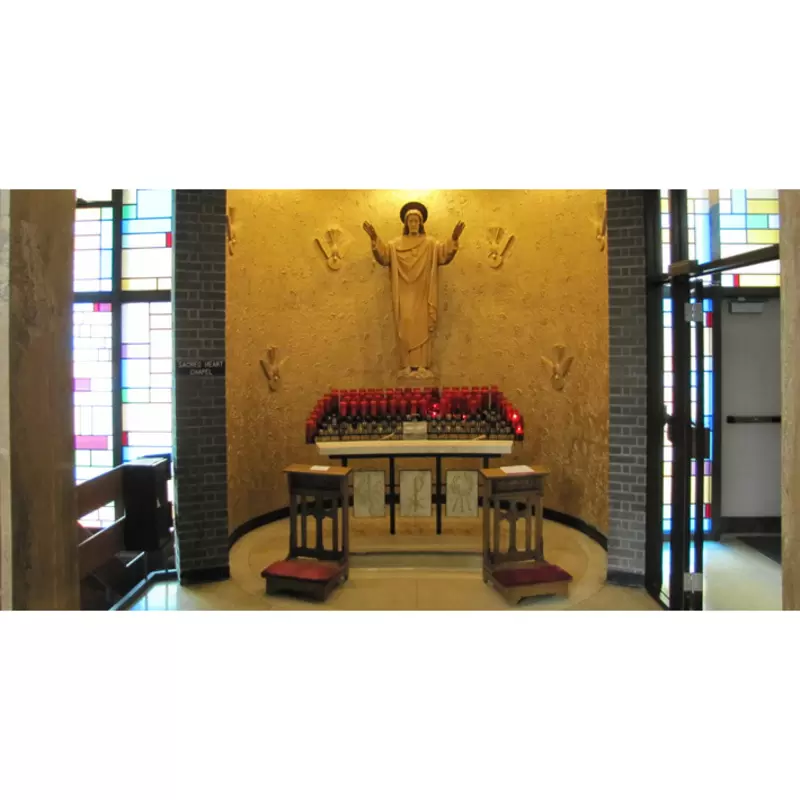
Sacred Heart Chapel
(Right hand side of the church) This chapel is dedicated to the Sacred Heart of Jesus. Notice the gold on the statue. The Sacred Heart is devotion, or a type of prayer, that has been around the Catholic Church for almost 1000 years.
It focuses on Jesus' suffering during Good Friday, when he was crucified. Notice the whip, spear, nails and crown of thorns in front of the candles. Another symbol in front of the candles is called a Chi-Rho (pronounced Kye Roe). It looks like an X and a P. They are the first two Greek letters in the word 'Christ'. Other symbols on the wall are doves - the sign of the Holy Spirit.
(Right hand side of the church) This chapel is dedicated to the Sacred Heart of Jesus. Notice the gold on the statue. The Sacred Heart is devotion, or a type of prayer, that has been around the Catholic Church for almost 1000 years.
It focuses on Jesus' suffering during Good Friday, when he was crucified. Notice the whip, spear, nails and crown of thorns in front of the candles. Another symbol in front of the candles is called a Chi-Rho (pronounced Kye Roe). It looks like an X and a P. They are the first two Greek letters in the word 'Christ'. Other symbols on the wall are doves - the sign of the Holy Spirit.
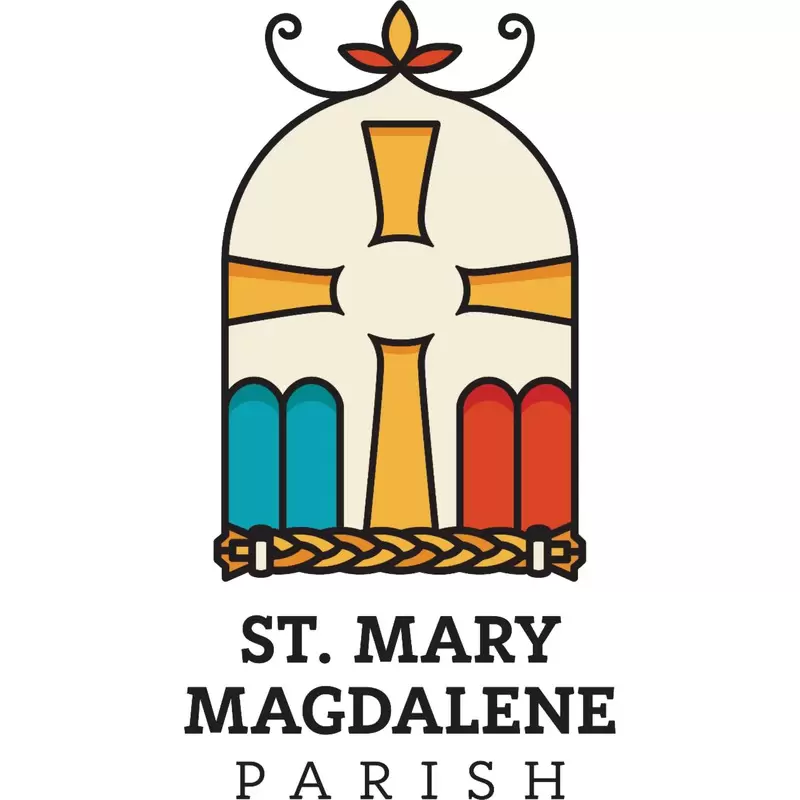
St. Mary Magdalene Parish Logo
The bar and crossbar of the Cross have a gentle, organic shape reminiscent of the Tau Cross of St Francis.
The Easter gold colour of the Cross symbolizes the Resurrection. Mary Magdalene was the first to announce the Good News of Christ’s Resurrection. One of the central missions of the disciples of Jesus Christ (all of us) is to encounter the Risen Christ and to share this Good News of His living presence among us.
Where the bar and crossbar meet, an area called the rays, is an ellipse shaped, borderless space. It is created thanks to a phenomenon called “closure” that relies on our human eye’s tendency to see closed shapes. Closure works where an object is incomplete or not fully traced, but in our mind, we perceive a complete shape by filling in the missing information. The egg shape it creates is the symbol of the universe, God’s Creation and the eclosion of Spirit into the world. It is also the iconographic symbol for Saint Mary Magdalene. The egg has rich symbolism in Christianity. It symbolizes Jesus coming forth from the tomb, Risen and Alive which brings new hope, new beginnings, and new directions for the followers of Jesus. Mary Magdalene was present at the empty tomb and experienced the Risen Christ there. She moved forward from this event with hope and new possibilities for her and those with whom she shared this Good News.
Under each arm of the cross is a stylized M. Together they represent the Two Mary’s at the foot of the cross. The blue M is for Mary the Mother of Jesus and the whole Church. The crimson M represents Mary Magdalene.
The braided sweetgrass at the foot of the cross respectfully acknowledges that the churches of St. Mary Magdalene Parish are located on unceded and unsurrendered traditional Wolastoqey territory. Sweetgrass represents the hair of our Earth Mother and is considered sacred medicine. Sweet grass teaches about our human responsibility to honour Earth Mother’s gifts by ensuring that they survive for the generations yet to be born. For that reason, we are asked to protect and keep the spirit of sacredness within all physical gifts through ceremony. Braided sweetgrass also symbolizes the connection of mind, body and spirit and embodies spiritual strength.
Each Wabanaki nation use the double curve motif to represent their identity. It is contained at the top of the logo and represents the life journey in the physical world. In the Wabanaki tradition it represents life in the womb, life in the physical world and return to the spirit world. In the Christian tradition it evokes the symbolism embedded in The Holy Trinity.
Logos are symbolic and carry more than what has been expressed in these few words of explanation. This Logo is available for you to pray with, reflect on and allow other meaningful connections that assist you in your spiritual and ministry journey.
The bar and crossbar of the Cross have a gentle, organic shape reminiscent of the Tau Cross of St Francis.
The Easter gold colour of the Cross symbolizes the Resurrection. Mary Magdalene was the first to announce the Good News of Christ’s Resurrection. One of the central missions of the disciples of Jesus Christ (all of us) is to encounter the Risen Christ and to share this Good News of His living presence among us.
Where the bar and crossbar meet, an area called the rays, is an ellipse shaped, borderless space. It is created thanks to a phenomenon called “closure” that relies on our human eye’s tendency to see closed shapes. Closure works where an object is incomplete or not fully traced, but in our mind, we perceive a complete shape by filling in the missing information. The egg shape it creates is the symbol of the universe, God’s Creation and the eclosion of Spirit into the world. It is also the iconographic symbol for Saint Mary Magdalene. The egg has rich symbolism in Christianity. It symbolizes Jesus coming forth from the tomb, Risen and Alive which brings new hope, new beginnings, and new directions for the followers of Jesus. Mary Magdalene was present at the empty tomb and experienced the Risen Christ there. She moved forward from this event with hope and new possibilities for her and those with whom she shared this Good News.
Under each arm of the cross is a stylized M. Together they represent the Two Mary’s at the foot of the cross. The blue M is for Mary the Mother of Jesus and the whole Church. The crimson M represents Mary Magdalene.
The braided sweetgrass at the foot of the cross respectfully acknowledges that the churches of St. Mary Magdalene Parish are located on unceded and unsurrendered traditional Wolastoqey territory. Sweetgrass represents the hair of our Earth Mother and is considered sacred medicine. Sweet grass teaches about our human responsibility to honour Earth Mother’s gifts by ensuring that they survive for the generations yet to be born. For that reason, we are asked to protect and keep the spirit of sacredness within all physical gifts through ceremony. Braided sweetgrass also symbolizes the connection of mind, body and spirit and embodies spiritual strength.
Each Wabanaki nation use the double curve motif to represent their identity. It is contained at the top of the logo and represents the life journey in the physical world. In the Wabanaki tradition it represents life in the womb, life in the physical world and return to the spirit world. In the Christian tradition it evokes the symbolism embedded in The Holy Trinity.
Logos are symbolic and carry more than what has been expressed in these few words of explanation. This Logo is available for you to pray with, reflect on and allow other meaningful connections that assist you in your spiritual and ministry journey.
Leadership Photos
Historical Photos
Church Address
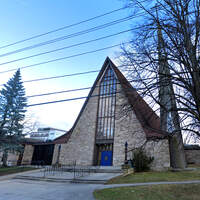
120 Regent Street
Fredericton,
NB
E3B 4Y9
Canada
Phone: 506-444-6001
Fax: 506-444-6006
Download St. Dunstan's Catholic Church vCard with Mass Times
Click here to contact the church
Church Pastor

Father Suresh Savariraj
Pastor
120 Regent Street
Fredericton,
NB
E3B 4Y9
Canada
Phone: 506-444-6001
Fax: 506-444-6006
Download Pastor Father Suresh Savariraj vCard
Click here to contact Father Suresh Savariraj
 Help me to avoid every sin
Help me to avoid every sin
Thanks to Thee, O God, that I have risen today, To the rising of this life itself; may it be to Thine own glory, O God of every gift, and to the glory, aid Thou my soul. With the aiding of Thine own mercy, even as I clothe my body with wool, cover Thou my soul with the shadow of Thy wing. Help me to avoid every sin, and the source of every sin to forsake, and as the mist scatters on the crest of the hills, may each ill haze clear from my soul, O God.
THANK YOU FOR VISITING ST. DUNSTAN'S CATHOLIC CHURCH ONLINE!
St. Dunstan's Catholic Church Accelerated Mobile Page (AMP)
